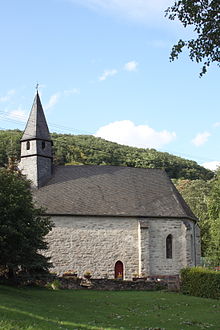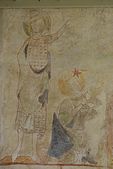Peterskapelle (Spay)
The Catholic Peterskapelle in Spay (in the Peterspay district), a local parish in the Mayen-Koblenz district in Rhineland-Palatinate , is very likely a Romanesque building that underwent a Gothic redesign around 1300 . Wall paintings from the first half of the 14th century have been preserved in the chapel .
history
The Apostle Peter consecrated chapel was in 1237 first mentioned in a document. In this the donation of the former noble own church to the monastery Eberbach is confirmed.
In 1656 the church with the extended patronage Peter and Paul was owned by the Martinsstift in Worms. At that time the altar was consecrated again , probably after being damaged during the Thirty Years' War , as the consecration crosses from this period show. In 1804, under the French times , the chapel was subordinated to the parish church of St. Lambertus and was used for worship until 1810. In the following years the chapel fell into disrepair.
Traces of Gothic wall paintings were first discovered in 1886. After the structural restoration of the chapel from 1919, the paintings were exposed in 1931/32 and the church painter Hermann Velte sen. from Darmstadt restored for the first time. In 1950, more paintings were uncovered and another restoration was carried out by Hermann Velte jun.
In 1980 the chapel was placed under a preservation order and in 1985 extensive renovation measures were initiated. In 1996, the cleaning and conservation of the wall paintings began.
architecture
Exterior construction
The building is made of quarry stone . The north side of the chapel has two ogival windows, on the south side there is a round arched side gate. The west facade is structured by a pointed arch portal , which, like the pointed arched twin window above, is embedded in a niche covered by a pointed arch. A small window breaks through the triangular gable. Over the western Langhausjoch sits on the slate-roofed gable roof a six-sided, completely verschieferter roof skylights that a pyramidal roof crowns.
The outer walls of the choir are structured by six buttresses with slate-covered shed roofs . The wall surfaces of the choir segments are pierced by pointed arch windows.
inner space
The Peterskapelle is designed as a hall church , 15 meters long and six meters wide. The nave is covered with a flat, repeatedly renewed wooden ceiling. The current ceiling was drawn in in 1998. The choir closes with a five-eighth closure and - like the rectangular choir bay - is covered with a ribbed vault. The remains of a piscina (right behind the altar) and a sacrament niche (in the north wall) have been preserved there.
Murals
The wall paintings in the church are dated to the first half of the 14th century.
Between the two windows on the north wall, St. Christopher is depicted as a three-meter-tall giant who carries Christ in the form of a child on his shoulders. He is revered as one of the Fourteen First Aiders. On its sides are two much smaller figures, one with a sword (left) and the other with a halberd (right), which are primarily intended to underline the superhuman size of the saint. Next to the right window, St. Catherine of Alexandria is shown with the attributes of her martyrdom, the sword and the wheel. Below are two figures, the one on the left carries a halberd.
The Last Judgment is depicted on the opposite south wall . In the middle, Christ is enthroned as judge of the world on a rainbow, two swords emerge from his mouth. The wounds of the Passion can be seen on his outstretched hands and on his feet . Maria kneels to his right . Beside her the blessed turn to a castle, the heavenly Jerusalem . John the Baptist kneels to the left of Jesus . Behind it a devil drives the damned to hell with a fork, where another devil awaits them. In the scene below, the resurrection of the dead is shown as small, naked figures rise from their graves and put their coffin lids on their side. Four trumpet-blowing angels, two in the middle and two on the edges of the scene, proclaim the judgment of the world.
The lowest scene shows the Passion story, which is only partially preserved and begins west of the side gate with the betrayal of Judas and the capture of Jesus. Judas can be seen in the midst of soldiers wearing armor from the early 14th century, kissing Jesus on the right cheek. Only fragments of the carrying of the cross, the flagellation and the crucifixion are preserved under the gallery .
On the west wall, the remains of a descent from the cross can still be seen. A scene of the weighing of souls is depicted on the north wall of the gallery . The left pan is filled with stones and five devils are trying to pull it down. In the right-hand pan there is a small, naked figure that weighs heavier. Whether the figure next to the scales is to be interpreted as the Archangel Michael or whether Christ himself can be seen in it remains open. Next to this scene is Saint Martin sitting on his horse and sharing his cloak with a beggar.
The depiction of the Last Judgment continues on the south side of the gallery. Here the throat of hell can be seen, in which the damned stew in the fire and which is opened by a pillar. A double-headed devil with faces on the arms and buttocks clings to it. Besides the jaws, only one eye is left of the monster's head.
The Twelve Apostles are represented in the choir . The names above were partially incorrectly added during the 1950 restoration. The Adoration of the Magi is depicted on the left above the triumphal arch . Mary and the baby Jesus are only partially preserved. The right depiction of a rider, whose shield and coat of arms are provided with a white cross, is interpreted as St. George . Like Saint Catherine and Saint Christopher, he belongs to the Fourteen Helpers in Need.
Choir floor
In the choir room, tiles have been preserved that are dated to the second half of the 13th century and, due to their size and motifs, presumably come from the workshop of the Eberbach monastery in the Rheingau. Since the tiles that are still in situ mostly do not follow any geometric order, it is assumed that they are used for a second time. The tiles are made of red, gray and gray-black clay and decorated with patterns such as an eagle in a circle, a lion, a seven-pointed star in a circle, lilies in a triangle or in the corners of a square.
Furnishing
- Box altar with masonry stipes and confessio and a devised sepulcrum visible from the front , possibly from the Gothic period
- Altar crucifix from the second half of the 16th century
- Piscina and sacrament niche
Monument protection
The Peterskapelle is a protected cultural monument according to the Monument Protection Act (DSchG) and registered in the list of monuments of the state of Rhineland-Palatinate . It is located in Peterspay , in the area of the local community Spay , exit towards Boppard. The Peterskapelle has been part of the UNESCO World Heritage Upper Middle Rhine Valley since 2002 .
literature
- Nicole Buchmann: Peterskapelle in Spay . Rheinische Kunststätten, No. 467. Rheinischer Verein für Denkmalpflege und Landschaftsschutz (Ed.), Cologne 2004, ISBN 3-88094-912-3 .
Web links
- Peterskapelle Spay sponsorship group with the current opening times of the chapel.
Individual evidence
- ^ General Directorate for Cultural Heritage Rhineland-Palatinate (ed.): Informational directory of cultural monuments - Mayen-Koblenz district. Mainz 2020, p. 91 (PDF; 5.8 MB).
Coordinates: 50 ° 14 '57 .8 " N , 7 ° 38' 16.8" E















